#option1
Explore tagged Tumblr posts
Note
Option twoooo for nobody else let’s goo🫶🏻
oooh okay noted 💅
#nobody else wonwoo#others gotta vote otherwise currently it's 1-1 for each option#one being mine in favour of option1 and the other being anon's in favour of option2#hehe
1 note
·
View note
Text
ToApril 2024
ToApril is once again upon us! Can you believe this is the third year this is taking place?
At this point we will assume everybody gets the concept of ToApril, but if you don’t, don’t hesitate to reach out!
Before we jump right into it, we want to emphasize the rules of toapril:
Please keep it TOA related. You can use characters from other series or your own, but the prompts were made with the characters of TOA in mind.
No NSFW. There are adults and minors alike participating and definitely browsing the internet within the fandom. Mature topics can be brought up, but anything graphic is not allowed.
Note: None of the prompts are ship based, but you are definitely allowed to include ships!
If you write a fic on ao3, please put it in the toapril 2024 collection. If you’re not sure how to do that, here are some instructions:
Option1: Go to the collection. There should be a button at the top right saying ‘post to collection’. Click that button and the rest should be as it would normally be when you post a fic.

Option 2: Post a new fic as usual, but in the associations section, type in toapril in the post to collections / challenges space and it should pop up. Make sure you add it in the 2024 one. It will stay open for a couple of weeks after April just in case you need more time to finish something.

If you want to post something on tumblr, please tag it with #toapril and #toapril2024. You can also tag this blog in your post, we would love to see all of your amazing works this year :D.
Have fun! If there’s any questions, don’t hesitate to ask.
Prompts below the cut.
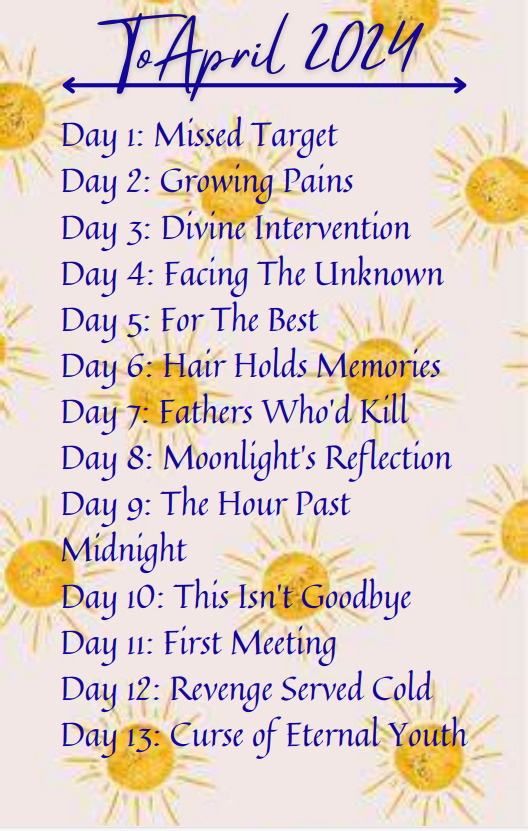
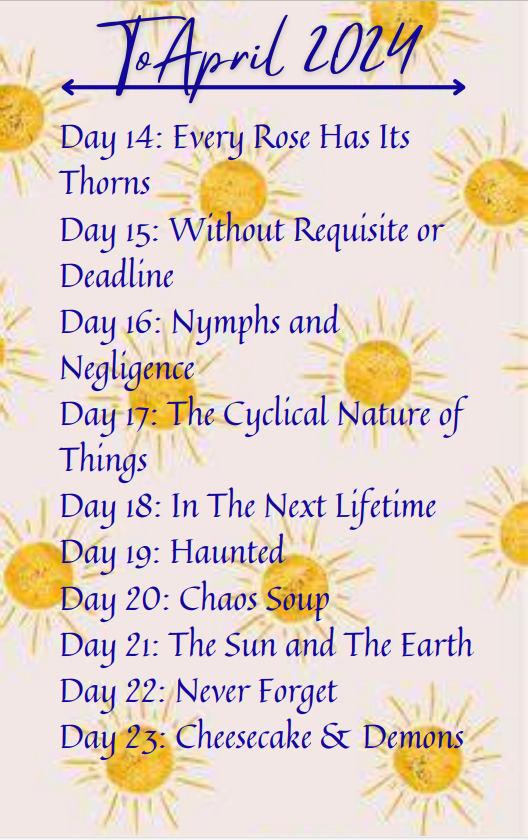
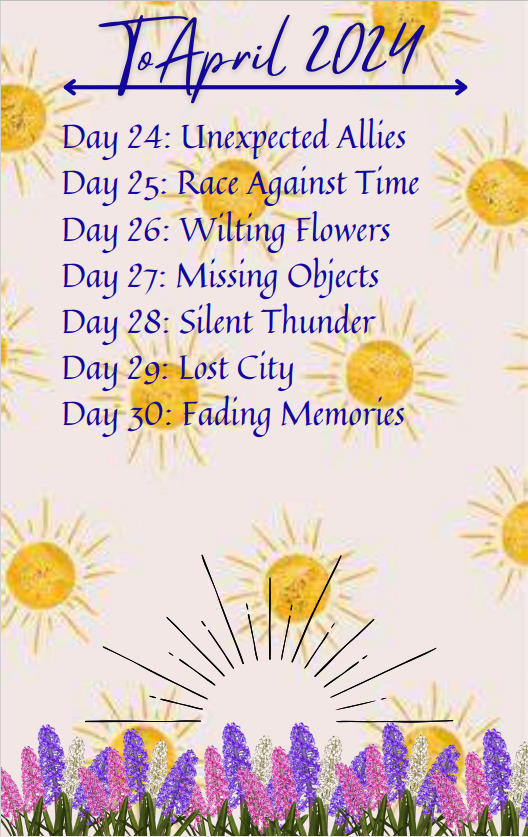
Text version:
Day 1: Missed Target
Day 2: Growing Pains
Day 3: Divine Intervention
Day 4: Facing The Unknown
Day 5: For The Best
Day 6: Hair Holds Memories
Day 7: Fathers Who’d Kill
Day 8: Moonlight’s Reflection
Day 9: The Hour Past Midnight
Day 10: This Isn’t Goodbye
Day 11: First Meeting
Day 12: Revenge Served Cold
Day 13: Curse of Eternal Youth
Day 14: Every Rose Has Its Thorns
Day 15: Without Requisite or Deadline
Day 16: Nymphs and Negligence
Day 17: The Cyclical Nature of Things
Day 18: In The Next Lifetime
Day 19: Haunted
Day 20: Chaos Soup
Day 21: The Sun and The Earth
Day 22: Never Forget
Day 23: Cheesecake & Demons
Day 24: Unexpected Allies
Day 25: Race Against Time
Day 26: Wilting Flowers
Day 27: Missing Objects
Day 28: Silent Thunder
Day 29: Lost City
Day 30: Fading Memories
Thank you to @okathleen, @star-flcwers, @worlds-oldest-teenager, @reostuffzies, @tsarinatorment, @nyaningthroughlife, @money-and-dandellions, @ferodactyl, @xxzephyrbreezexx, and @solahflare for submitting these prompts.
92 notes
·
View notes
Note
Hi so sorry to bother you but I want to learn how to make IFs, so I've been using twine and trying to learn how to use sugarcube but like how 😭😭😭
Babes I am so embarassed I'm literally studying computer science oh my god. Like in theory I know that programming languages are different but this is the first time java vs javascript is really hitting,,,,
Do you have links to any resources you used to learn? Like how you randomized variables (for the 'i'm into both men and women' option's gender setting) and how to do the pronoun thing properly, and stuff like the codex, plus if you can how you customized that sidebar
Thank you and I'm sorry to bother you!!
No worries at all!! Here's a masterlist of Twine resources you can use for the things you mentioned and more. It includes tutorials for beginners, including multiple different ways on how to code pronouns, CSS customization and templates for your game, etc.
For the randomization of variables, the line of code you want is <<set $variable to either("option1", "option2", "option3", ...)>>
But for my purposes specifically, to maintain an even 2 male/2 female LI split, I had to use the code in a little more convoluted way since randomizing all the genders with that code could end up with an "uneven" balance (like 3 out of 4 LIs being randomized as female, or all LIs ending up as male).
If you want to do something similar with having a 2 male/2 female LI randomization, here's how I went about it, though I'm sure there's a much quicker way to do it. Mind you I was a total beginner when I wrote this haha:

Basically what this does is randomize R's gender and randomize X's gender first to either male or female with the first two lines. If R and X are both set as male or female, then A and D will both be set as the opposite. If R and X are set as different genders, however, then A's gender will be randomized next. Then, based on whether A is male or female, D's gender will be selected to complete the 2/2 split.
Hope this helps!!
132 notes
·
View notes
Text
14 BETTER GAMEPLAY MODS
youtube
DL⇩
Pile of Laundry Default Replacement {option1}
Pile of Laundry Default Replacement {option2}
Folded Laundry Default Replacement
「 quip oral care set 」
Sponge Override
Samsung Galaxy Z Flip (Decor and Default Override)
no zzz
the missing plumbob
Bauney Pods Max (Gift)
Cutting Board Override
Working Pet Water Bowls (Cats & Dogs)
Sunrise Alarm Clock
Insimnia Eats 2.0 delivery
Insimnia Eats Krispy Cream
⇩Mod Creators ⇩Thank you for these amazing mods🤩
@sims41ife @largetaytertots @dscombobulate @channel4sims-cc
@ddaeng-sims @kyrs29 @mintvalentine @pox @littlemssam @lot51
@insimniacreations

Patreon|Youtube | TikTok | Tumblr | Amazon Storefront
#sims 4 mods you need#sims 4 cc finds#ts4mods#thesims4#sims 4 mods#sims 4 gameplay#sims 4 cc#urban simmer#sims 4 mod finds#sims 4 mod review#ts4cc#black simmer#Functional#The sims 4 food#ts4 food#Youtube
74 notes
·
View notes
Text


#mine is currently shoulder length (short with layers)#very dark brown too#just don’t know what i should or if i should even do it at all#twenty one pilots#tyler joseph#joshua dun#clancy#clancy tour
5 notes
·
View notes
Note
"Up high and aloft": #3 (or 4) & #5. "I saw you today": #10 & #15 :)
hi steph! thank you!!
For Up high and aloft
3: What’s your favorite line of narration?
So they lie in the mess that spills out when you smash a snowglobe and trade one half of a battery at the deadline
I went a bit heavy-handed on the snowglobe metaphor but I think that I like it and especially this line. It's very sensation-based; wet and sharp and you know you have to clean it/yourselves up without hurting yourself more on the glass...
5: What part was hardest to write?
Probably trying to find the "word bank" words for the second half or so. The start of it really just came out, and I wasn't originally going to have the words changing, it was just going to be like "words words words (option1/option2/option3) words words". Then I realized it was going to be way too long and hard to read, so I adjusted to writing it with the refreshing for new words in mind. Because the second half was a bit more intentional, I was thinking a bit harder about where to put the changing bits in and what to make them, and I got a bit in my head about it.
For I saw you today:
10: Why did you choose this pairing for this particular story?
I actually wrote the first section with no real pairing in mind back in December, and then I opened it up again recently and wondered who I could make it about. I decided basically that I didn't want to put names in it explicitly, so I thought about who I could imply and have it make sense if you know, and then I remembered the ridiculous Springer/Varsho ear thing and that's why I chose them and especially Varsho. Then I went back to edit a few things from the beginning (adding the right field bit, fixing a few other minor things) to make it make sense for them. Mostly I decided that Varsho might as well be a concerned and horny gay person because why not, to be very honest, and then Springer just followed from that
15: What did you learn from writing this fic?
Mostly that I am incapable of judging my own poetry really. I thought it was kind of not good and than I sent it to my gay person as a last ditch "get me out of my head about this, tell me if it's good or if it's garbage just make me stop wondering/worrying", and then they told me it's good and worth posting and to calm down lmao. And now that I've had more time to think about it I decided that I do actually like it!
2 notes
·
View notes
Text
Another crochet poll: Further, closer, or closest?



[Id: three photos of the same incomplete crochet octopus is pastel yellow and pink, with small, shiny black eyes positioned first far away, on almost opposite sides of the head, then closer, then very close together like on a human face End ID.]
This is a poll:
Which one do you like best?
Option1 : Further
Option 2: closer
Option 3: closest
7 notes
·
View notes
Text
Hiveminders, where should my pin go?
option1

option2

option3

option4

option5

#hivemind tv#riley savage#graydon weaver#dignan#their tour was so fun I had the best time#And I got a little trinket :3#Polls#outside the house
3 notes
·
View notes
Text
Chef WK, lead charcuterie specialist in Alberta Canada
Table of contents
1. Control Program Requirements for Fermented Meat Products
2. Facility and Equipment Requirements
3. Starter Culture
4. Chemical Acidification
5. Water Activity Critical Limits
6. Time and Temperature for Fermented Products
7. Fermentation Done at a Constant Temperature
8. Examples of Degree-hours at constant room temperatures
9. Fermentation Done at Different Temperatures
10. Fermentation done at Different temperatures
11. What happens if fermentation fails to hit critical limit?
12. E. coli and Salmonella Control in Fermented Sausages
13. Options for E. coli validation
14. Option1; Heating
15. Option 2; pH, heating, holding, diameter
16. Safety and consistency
Control Program Requirements for Fermented Meat Products
The producer must have a program in place to assess the incoming product. This program should outline specifications for the incoming ingredients. This may include criteria including receiving temperature, farm/ supplier, lot code or packed on date, species/cut etc.
2. Facility and Equipment Requirements
Equipment used in the fermentation process must be included in the operator's prerequisite control programs. These must include the following elements:
Temperature in the fermentation, drying and smoking chambers must be uniform and controlled to prevent any fluctuation that could impact on the safety of the final product.
Fermentation, drying and smoking chambers must be equipped with a shatter resistant indicating thermometer, (or equivalent), with graduations of 1°C��or less. If mercury thermometers are used, their mercury columns must be free from separations. All thermometers must be located such that they can be easily read.
Fermentation and smoking chambers must be equipped with a recording thermometer for determining degree-hours calculations in a reliable manner. Recording thermometers are also preferable in drying and aging rooms but, in these rooms, it may be sufficient to read and record the temperatures 2 times a day.
Drying and aging rooms must be equipped with humidity recorders in order to prevent uncontrolled fluctuations of the relative humidity. The only alternative to an automatic humidity recorder in these rooms would be for the company to manually monitor and record ambient humidity twice a day (morning and afternoon) every day with a properly calibrated portable humidity recorder.
For routine monitoring, accurate measurement electronic pH meters (± 0.05 units) should be employed. It is important that the manufacturer's instructions for use, maintenance and calibration of the instrument as well as recommended sample preparation and testing be followed.
When the aw of a product is a critical limit set out in the HACCP plan for a meat product, accurate measurement devices must be employed. It is important that the manufacturer's instructions for use, maintenance and calibration of the instrument be followed.
3. Starter Culture
The operator must use a CFIA approved starter culture. This includes Freeze-dried commercially available culture as well as back-slopping (use of previously successful fermented meat used to inoculate a new batch). When performing back-slopping, the operator must have a control program in place to prevent the transmission of pathogens from when using the inoculum from a previous batch to initiate the fermentation process of a new batch. These must include:
The storage temperature must be maintained at 4°C or less and a pH of 5.3 or less.
Samples for microbiological analysis must be taken to ensure that the process is in line with the specifications.
The frequency of sampling is to be adjusted according to compliance to specifications.
Any batch of inoculum which has a pH greater than 5.3 must be analysed to detect at least Staphylococcus aureus. Only upon satisfactory results will this inoculum be permitted for use in back slopping.
This can be an expensive and a time exhaustive process and is generally avoided due to food safety concerns. AHS does not allow back-slopping.
[Chef WK was in communication with the U of A to get his method, a starter mix, studied.]
4. Chemical Acidification
If product is chemically acidified by addition of citric acid, glucono-delta-lactone or another chemical agent approved for this purpose, controls must be in place and records kept to ensure that a pH of 5.3 or lower is achieved by the end of the fermentation process. These acids are encapsulated in different coatings that melt at specific temperatures, which then release the powdered acids into the meat batter and directly chemically acidulate the protein.
Summer sausage is a very common chemically acidified product. The flavor profile tends to be monotone and lacking depth.
5. Water Activity Critical Limits
The aw may be reduced by adding solutes (salt, sugar) or removing moisture.
Approximate minimum levels of aw (if considered alone) for the growth of:
molds: 0.61 to 0.96
yeasts: 0.62 to 0.90
bacteria: 0.86 to 0.97
Clostridium botulinum: 0.95 to 0.97
Clostridium perfringens: 0.95
Enterobacteriaceae: 0.94 to 0.97
Pseudomonas fluorescens: 0.97
Salmonella: 0.92 - 0.95
Staphylococcus aureus: 0.86
parasites: Trichinella spiralis will survive at an aw of 0.93 but is destroyed at an aw of 0.85 or less.
The above levels are based on the absence of other inhibitory effects such as nitrite, competitive growth, sub-optimum temperatures, etc., which may be present in meat products. In normal conditions, Staphylococcus aureus enterotoxins are not produced below aw 0.86, although in vacuum packed products this is unlikely below aw 0.89.
6. Time and Temperature for Fermented Products
Certain strains of the bacteria Staphylococcus aureus are capable of producing a highly heat stable toxin that causes illness in humans. Above a critical temperature of 15.6°C, Staphylococcus aureus multiplication and toxin production can take place. Once a pH of 5.3 is reached, Staphylococcus aureus multiplication and toxin production are stopped.
Degree-hours are the product of time as measured in hours at a particular temperature multiplied by the "degrees" measured in excess of 15.6°C (the critical temperature for growth of Staphylococcus aureus). Degree-hours are calculated for each temperature used in the process. The limitation of the number of degree-hours depends upon the highest temperature in the fermentation process prior to the time that a pH of 5.3 or less is attained.
The operator is encouraged to measure temperatures at the surface of the product. Where this is not possible, the operator should utilize fermentation room temperatures. The degree hour calculations are based on fermentation room temperatures. Temperature and humidity should be uniform throughout the fermentation room.
A process can be judged as acceptable provided the product consistently reaches a pH of 5.3 using:
fewer than 665 degree-hours when the highest fermentation temperature is less than 33°C;
fewer than 555 degree-hours when the highest fermentation temperature is between 33° and 37°C; and
fewer than 500 degree-hours when the highest fermentation temperature is greater than 37°C.
This means that as the temperature increases, the amount of time that you have available to reach 5.3 or under is shorter. The warmer the temperature, the sharper the log growth phase of bacteria, which equates to more overshoot in lactic acid production, faster.
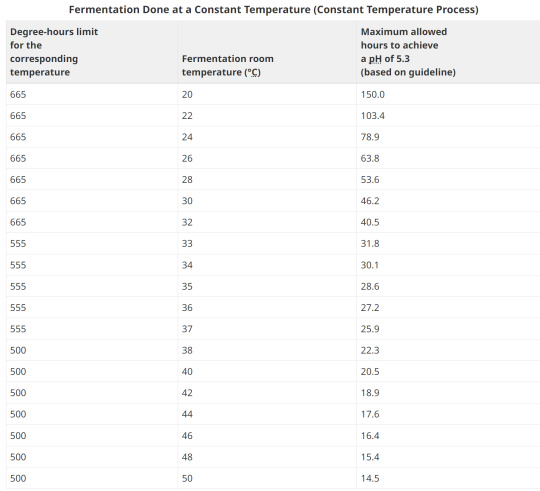
8. Examples of Degree-hours at constant room temperatures
Example 1:
Fermentation room temperature is a constant 26°C. It takes 55 hours for the pH to reach 5.3.
Degrees above 15.6°C: 26°C - 15.6°C = 10.4°C Hours to reach pH of 5.3: 55 Degree-hours calculation: (10.4°C) x (55) = 572 degree-hours
The corresponding degree-hours limit (less than 33°C) is 665 degree-hours.
Conclusion: Example 1 meets the guideline because its degree-hours are less than the limit.
Example 2:
Fermentation room temperature is a constant 35°C. It takes 40 hours for the pH to reach 5.3.
Degrees above 15.6°C: 35°C - 15.6°C = 19.4°C Hours to reach pH of 5.3: 40 Degree-hours calculation: (19.4°C) x (40) = 776 degree-hours
The corresponding degree-hours limit (between 33 and 37°C) is 555 degree-hours.
Conclusion: Example 2 does not meet the guideline because its degree-hours exceed the limit
9. Fermentation Done at Different Temperatures
When the fermentation takes place at various temperatures, each temperature step in the process is analyzed for the number of degree-hours it contributes. The degree-hours limit for the entire fermentation process is based on the highest temperature reached during fermentation.
Example 1:
It takes 35 hours for product to reach a pH of 5.3 or less. Fermentation room temperature is 24°C for the first 10 hours, 30°C for second 10 hours and 35°C for the final 15 hours.
Step 1
Degrees above 15.6°C: 24°C - 15.6°C = 8.4°C Hours to reach pH of 5.3: 10 Degree-hours calculation: (8.4°C) x (10) = 84 degree-hours
Step 2
Degrees above 15.6°C: 30°C - 15.6°C = 14.4°C Hours to reach pH of 5.3: 10 Degree-hours calculation: (14.4°C) x (10) = 144 degree-hours
Step 3
Degrees above 15.6°C: 35°C - 15.6°C = 19.4°C Hours to reach pH of 5.3: 15 Degree-hours calculation: (19.4°C) x (15) = 291 degree-hours
Degree-hours calculation for the entire fermentation process = 84 + 144 + 291 = 519
The highest temperature reached = 35°C
The corresponding degree-hour limit = 555 (between 33°C and 37°C)Conclusion: Example 1 meets the guideline because its degree-hours are less than the limit.
10. Fermentation done at Different temperatures
Example 2:
It takes 38 hours for product to reach a pH of 5.3 or less. Fermentation room temperature is 24°C for the first 10 hours, 30°C for the second 10 hours and 37°C for the final 18 hours.
Step 1
Degrees above 15.6°C: 24°C - 15.6°C = 8.4°C Hours to reach pH of 5.3: 10 Degree-hours calculation: (8.4°C) x (10) = 84 degree-hours
Step 2
Degrees above 15.6°C: 30°C - 15.6°C = 14.4°C Hours to reach pH of 5.3: 10 Degree-hours calculation: (14.4°C) x (10) = 144 degree-hours
Step 3
Degrees above 15.6°C: 37°C - 15.6°C = 21.4°C Hours to reach pH of 5.3: 18 Degree-hours calculation: (21.4°C) x (18) = 385.2 degree-hours
Degree-hours calculation for the entire fermentation process = 84 + 144 + 385.2 = 613.2
The highest temperature reached = 37°C
The corresponding degree-hour limit = 555 (between 33°C and 37°C)
Conclusion: Example 2 does not meet the guidelines because its degree-hours exceed the limit.
11. What happens if fermentation fails to hit critical limit?
What happens if the batch takes longer than degree-hours allows? For restaurant level production, it's always safer to discard the product. The toxin that Staph. Aureus produces is heat stable and cannot be cooked to deactivate. In large facilities that produce substantial batches, the operator must notify the CFIA of each case where degree-hours limits have been exceeded. Such lots must be held and samples of product submitted for microbiological laboratory examination after the drying period has been completed. Analyses should be done for Staphylococcus aureus and its enterotoxin, and for principal pathogens, such as E. coli O157:H7, Salmonella, and Clostridium botulinum and Listeria monocytogenes.
If the bacteriological evaluation proves that there are fewer than 104 Staphylococcus aureus per gram and that no enterotoxin or other pathogens are detected, then the product may be sold provided that it is labelled as requiring refrigeration.
In the case of a Staphylococcus aureus level higher than 104 per gram with no enterotoxin present the product may be used in the production of a cooked product but only if the heating process achieves full lethality applicable to the meat product.
In the case where Staphylococcus aureus enterotoxin is detected in the product the product must be destroyed.
12. E. coli and Salmonella Control in Fermented Sausages
Business' that manufacture fermented sausages are required to control for verotoxinogenic E. coli including E. coli O157:H7 and Salmonella when they make this type of product. This includes:
establishments which use beef as an ingredient in a dry or semi-dry fermented meat sausage;
establishments which store or handle uncooked beef on site;
Establishments which do not use beef and do not obtain meat ingredients from establishments which handle beef are not currently required to use one of the five options for the control of E. coli O157:H7 in dry/semi-dry fermented sausages.
Any processed RTE product containing beef or processed in a facility that also processed beef, must be subjected to a heat treatment step to control E. coli O157:H7. Heating to an internal temperature of 71°C for 15 seconds or other treatment to achieve a 5D reduction is necessary. This is a CFIA requirement and is not negotiable.
Uncooked air dried products produced as RTE, must meet shelf stable requirements as detailed for Fermented-Dry products.
13. Options for E. coli validation
Without lab testing, the two main methods of validation are with heat treating by either low temp and a long duration, or various hotter processing temperatures for a shorter timeframe.
A challenge study to validate a process can take 1 year and over $100,000!
14. Option1; Heating
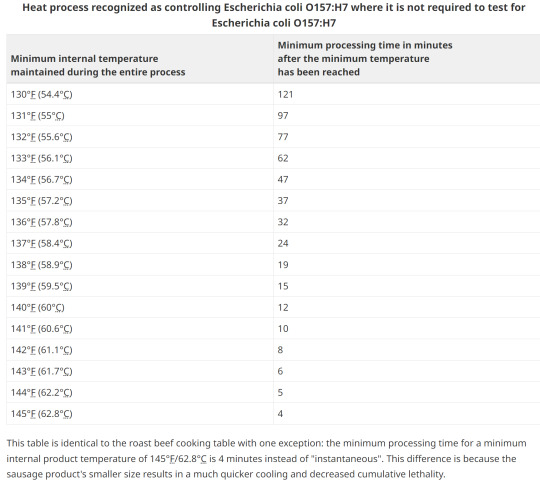
15. Option 2; pH, heating, holding, diameter
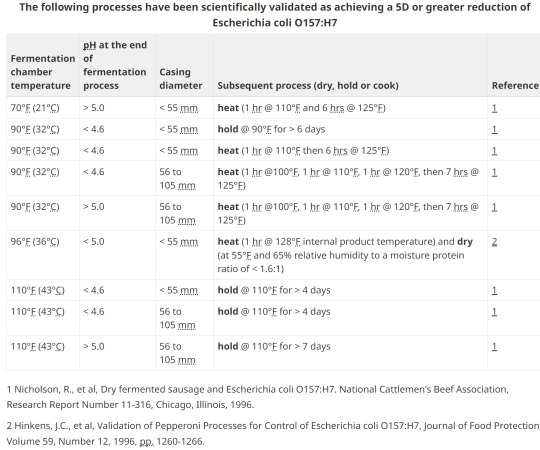
16. Safety and consistency
The aw and pH values are critical in the control of pathogens as well as to ensure shelf-stability in all semi-dry and dry fermented meat products. Each batch must be tested for aw and/or pH in order to verify that the critical limits are met.
Although aw measurement is mandatory only for shelf stable products, it is strongly recommended that the producer determine the aw values achieved for each product type they manufacture and for each product. Once this has been established, frequent regular checks should be made to ensure consistency. In the U.S., they rely on moisture to protein ratio and have set targets. This lab-tested value is a direct correlation of the % water to % meat protein and not aw. This gives more consistency to common names. For example, to legally call a product "jerky" it must have a MPR of 0.75:1 or lower. Remember your ABCs:
Always be compliant.
-AND-
Documentation or it didn't happen.
(tags)
Charcuterie,Fermented Meat,Food Safety,Starter Culture,Chemical Acidification,Water Activity,Fermentation Process,Degree-Hours Method,Foodborne Pathogens,Meat Processing Guidelines,Chef WK Alberta Canada,Food Industry Standards,pH Critical Limits,Thermal Processing,Food Preservation,Food Microbiology,Sausage Fermentation,Charcuterie Expertise,Fermented Meats ,Food Safety Standards,Food Processing Guidelines,Starter Cultures,Chemical Acidification,Water Activity (a_w),Critical Limits,Degree-Hours Method,Foodborne Pathogens,Meat Processing Equipment,Processing Facility Requirements,Hazard Analysis and Critical Control Points (HACCP),Food Preservation Techniques,Temperature Control,Pathogen Reduction,Food Industry Compliance,Documentation Practices,Heat Treatment,pH Control,Food Stability,Consistency in Production,Microbial Testing,Real-time Monitoring,Process Validation,Regulatory Requirements,Verotoxigenic E. coli,Lethality Standards,Product Labelling,Spoilage Prevention,Enterotoxin Detection,Shelf-Stable Products,Moisture to Protein Ratio (MPR)
#Charcuterie#Fermented Meat#Food Safety#Starter Culture#Chemical Acidification#Water Activity#Fermentation Process#Degree-Hours#Meat Processing Guidelines#Thermal Processing#Food Preservation#Food Microbiology#Sausage Fermentation#Starter Cultures#Critical Limits#Meat Processing#Food Preservation Techniques#Temperature Control#Pathogen Reduction#Food Industry#Heat Treatment#pH Control#Food Stability#Microbial Testing#Real-time Monitoring#Process Validation#Spoilage Prevention#Enterotoxin Detection#Shelf-Stable Products#Moisture to Protein Ratio (MPR)
2 notes
·
View notes
Text

okay so i made a little drawing thingy for the 3 different ways i can animate/style the gameplay and animations of the base attack of moon. moons attack is basically just shooting a flying fist thats it but i have been thinking about it since i just decided that when you attack you will not be able to move (except for a few exceptions like a dash attack combo where you can attack and dash at the same time)
BUTT here are the 3 options option1 (my fav) moon slashes with their arm across the front of their vision and a little slash gets animated, then a fist get shot out, since its a slash it can go in any direction and won't look as ugly
option 2 moon will have 2 (or 1) floating arms around them that shoot out more fists OR some other type of missile maybe just a bullet lol.
option 3 moon has 1 or 2 floating fists around him and when they attack one of the fists shoot away and then later returns to them. (this would fuck with a lot of stuff tho...)
#pixel game#pixel art#pixel illustration#pixelart#programming#game development#game design#game dev update#indie game dev#coding#game dev#game developers#indie dev#indiegamedev#game dev stuff#indie game#game dev blog#sprites#pixel sprite#sprite art#sprite edit#my sprites#pixel
3 notes
·
View notes
Text
7 notes
·
View notes
Text
Steps to install management agent for OEM
Step 1: Log in to Oracle Enterprise Manager1. Open a web browser and navigate to the Enterprise Manager Cloud Control URL.2. Log in with your administrative credentials.Step 2: Navigate to the “Add Target” Option1. From the Enterprise Manager homepage, go to Setup (top-right corner).2. Select Add Target → Add Targets Manually.Step 3: Install the Management Agent (if required)If the target is on a…
0 notes
Note
Hey!
Hope you are doing I would love to participate in Valentine's game

Option1
Sorry it's closed, next time
0 notes
Text
🔥 BULENOX 83% LIFETIME OPTION1
✅ Coupon: ONELINER83
📢 http://bulenox.de
⚠️ 02/05/24 - 11:59 PM

0 notes
Text
This is a poll
Question: Do you have any significant others?
Option1: No, but I want one.
Option 2: No, but I want multiple.
Option 3: No, I and I don't want any
Option 4: No, I'm not interested in relationships right now.
Option 5: Yes, I have a significant other
Option 6: Yes, I have multiple significant others
Option 7: [An option I forgot to list because this is spur of the moment]
Option 8: I don't want to vote but I want to see the answers
9 notes
·
View notes